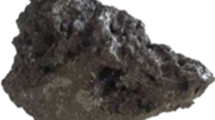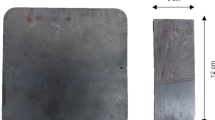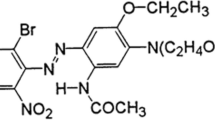Abstract
Indigo carmine (IC) is a dye that is widely used in textile industries. Since the dyes lixiviation reaches about 30%, these compounds are largely discharged in effluents, thus contaminating rivers and lakes. The IC presents high toxicity, causing topic irritation and carcinogenic effects. Electrocoagulation (EC) is based on the electrical dissolution of iron and aluminum ions used to promote the formation of metal hydroxide coagulants capable of destabilizing and aggregating pollutant compounds. In this context, this work aimed to investigate the use of electrodes obtained from the direct compression of metallurgical filing wastes on the EC remediation of IC. Electrodes of bronze, aluminum, steel and metal waste were produced and their performances were evaluated in NaCl 0.05 mol L−1 and tap water solutions at 2.5 and 5 V. The IC dye discoloration reached 84% for the aluminum commercial electrode, 90% for the steel commercial electrode and 96% for the bronze commercial electrode, respectively, in 80 min of treatment. For electrodes produced from chips (swarf), there was a discoloration of 72% for the aluminum electrode, 92% for the steel electrode and 90% for the bronze electrode, respectively, in the same time of treatment. These results showed that electrodes obtained from chips and commercial electrodes had similar electrochemical efficiency in the removal of IC dye from wastewater. Also, the use of metallic debris as electrodes makes its application an economically viable option on a large scale, since they have high effectiveness and lower cost and their replacement can solve the electrode passivation.





Similar content being viewed by others
References
Alinsafi A, Khemis M, Pons MN et al (2005) Electro-coagulation of reactive textile dyes and textile wastewater. Chem Eng Process Process Intensif 44:461–470. https://doi.org/10.1016/J.CEP.2004.06.010
Barka N, Assabbane A, Nounah A, Ichou YA (2008) Photocatalytic degradation of indigo carmine in aqueous solution by TiO2-coated non-woven fibres. J Hazard Mater 152:1054–1059. https://doi.org/10.1016/j.jhazmat.2007.07.080
Beluci NDCL, Mateus GAP, Miyashiro CS et al (2019) Hybrid treatment of coagulation/flocculation process followed by ultrafiltration in TIO2-modified membranes to improve the removal of reactive black 5 dye. Sci Total Environ 664:222–229. https://doi.org/10.1016/J.SCITOTENV.2019.01.199
Bernal M, Romero R, Roa G et al (2013) Ozonation of indigo carmine catalyzed with Fe-pillared clay. Int J Photoenergy 2013:1–7. https://doi.org/10.1155/2013/918025
da Costa CE, Zapata WC, Parucker ML (2003) Characterization of casting iron powder from recycled swarf. J Mater Process Technol 143–144:138–143. https://doi.org/10.1016/S0924-0136(03)00394-7
de Carvalho TEM, Fungaro DA, Magdalena CP, Cunico P (2011) Adsorption of indigo carmine from aqueous solution using coal fly ash and zeolite from fly ash. J Radioanal Nucl Chem 289:617–626. https://doi.org/10.1007/s10967-011-1125-8
Devarahosahalli Veeranna K, Theeta Lakshamaiah M, Thimmasandra Narayan R (2014) Photocatalytic degradation of indigo carmine dye using calcium oxide. Int J Photochem 2014:1–6. https://doi.org/10.1155/2014/530570
Eyvaz M, Gürbulak E, Kara S, Yüksel E (2014) Preventing of cathode passivation/deposition in electrochemical treatment methods—a case study on winery wastewater with electrocoagulation, Chap 8. In: Modern electrochemical methods in nano, surface and corrosion science. InTech, pp 202–238. https://doi.org/10.5772/58580
Fajardo AS, Martins RC, Silva DR et al (2017) Dye wastewaters treatment using batch and recirculation flow electrocoagulation systems. J Electroanal Chem 801:30–37. https://doi.org/10.1016/J.JELECHEM.2017.07.015
Fischer-Colbrie G, Maier J, Robra KH, Guebitz GM (2005) Degradation of the indigo carmine dye by an anaerobic mixed population. In: Lichtfouse E, Schwarzbauer J, Robert D (eds) Environmental chemistry. Springer, Berlin, Heidelberg, pp 289–294. https://doi.org/10.1007/3-540-26531-7_27
Garcia LF, Rodrigues Siqueira AC, Lobón GS et al (2017) Bio-electro oxidation of indigo carmine by using microporous activated carbon fiber felt as anode and bioreactor support. Chemosphere 186:519–526. https://doi.org/10.1016/j.chemosphere.2017.08.033
GilPavas E, Dobrosz-Gómez I, Gómez-García M-Á (2019) Optimization and toxicity assessment of a combined electrocoagulation, H2O2/Fe2+/UV and activated carbon adsorption for textile wastewater treatment. Sci Total Environ 651:551–560. https://doi.org/10.1016/J.SCITOTENV.2018.09.125
Hassan MM, Carr CM (2018) A critical review on recent advancements of the removal of reactive dyes from dyehouse effluent by ion-exchange adsorbents. Chemosphere 209:201–219. https://doi.org/10.1016/J.CHEMOSPHERE.2018.06.043
Kabdaşlı I, Arslan-Alaton I, Ölmez-Hancı T, Tünay O (2012) Electrocoagulation applications for industrial wastewaters: a critical review. Environ Technol Rev 1:2–45. https://doi.org/10.1080/21622515.2012.715390
Kobya M, Ozyonar F, Demirbas E et al (2015) Arsenic removal from groundwater of Sivas-Şarkişla Plain, Turkey by electrocoagulation process: comparing with iron plate and ball electrodes. J Environ Chem Eng 3:1096–1106. https://doi.org/10.1016/J.JECE.2015.04.014
Lakshmi UR, Srivastava VC, Mall ID, Lataye DH (2009) Rice husk ash as an effective adsorbent: evaluation of adsorptive characteristics for indigo carmine dye. J Environ Manag 90:710–720. https://doi.org/10.1016/J.JENVMAN.2008.01.002
Lima Morais R, Ferreira Garcia L, Kussmaul E et al (2019) Electrochemical remediation of industrial pharmaceutical wastewater containing hormones in a pilot scale treatment system. Eclética Química J 44:40–52. https://doi.org/10.26850/1678-4618eqj.v44.1.40-52
López-Vizcaíno R, Yustres A, Sáez C et al (2019) Techno-economic analysis of the scale-up process of electrochemically-assisted soil remediation. J Environ Manag 231:570–575. https://doi.org/10.1016/J.JENVMAN.2018.10.084
Malinovic BN, Pavlovic MG (2016) Decolorization of reactive violet 5 dye in textile wastewater by electrocoagulation. J Electrochem Sci Eng 6:67. https://doi.org/10.5599/jese.223
Mall ID, Taneja N, Thakur CK (2013) Treatment of indigo carmine dye bearing wastewater by electrocoagulation. In: 2nd International conference on environment, agriculture and food sciences, Malaysia, pp 86–90
Manu B (2007) Physico-chemical treatment of indigo dye wastewater. Color Technol 123:197–202. https://doi.org/10.1111/j.1478-4408.2007.00080.x
Moussa DT, El-Naas MH, Nasser M, Al-Marri MJ (2017) A comprehensive review of electrocoagulation for water treatment: potentials and challenges. J Environ Manag 186:24–41. https://doi.org/10.1016/J.JENVMAN.2016.10.032
Naraghi B, Baneshi MM, Amiri R et al (2018) Removal of reactive black 5 dye from aqueous solutions by coupled electrocoagulation and bio-adsorbent process. Electron Physician 10:7086–7094. https://doi.org/10.19082/7086
Özyurt B, Camcıoğlu Ş (2018) Applications of combined electrocoagulation and electrooxidation treatment to industrial wastewaters, Chap 4. In: Wastewater and water quality. InTech, pp 71–89. https://doi.org/10.5772/intechopen.75460
Paz A, Carballo J, Pérez MJ, Domínguez JM (2017) Biological treatment of model dyes and textile wastewaters. Chemosphere 181:168–177. https://doi.org/10.1016/j.chemosphere.2017.04.046
Rios GB, Almeraya F, Herrera MTA (2009) Electrode passivation in the electrocoagulation process. Port Electrochim Acta 23:17–34. https://doi.org/10.4152/pea.200501017
Salmani ER, Ghorbanian A, Ahmadzadeh S et al (2016) Removal of reactive red 141 dye from synthetic wastewater by electrocoagulation process: investigation of operational parameters. Iran J Heal Saf Environ 3:403–411
Secula MS, Crežescu I, Petrescu S (2011) An experimental study of indigo carmine removal from aqueous solution by electrocoagulation. Desalination 277:227–235. https://doi.org/10.1016/j.desal.2011.04.031
Singh Z, Chadha P (2005) Human health hazard posed by textile dyes: a genotoxic perspective. J Hum Heal 1:42–45
Stergiopoulos D, Dermentzis K, Giannakoudakis P, Sotiropoulos S (2014) Electrochemical decolorization and removal of indigo carmine textile dye from wastewater. Glob NEST J 16:499–506
Subramani AK, Byrappa K, Ananda S et al (2007) Photocatalytic degradation of indigo carmine dye using TiO2 impregnated activated carbon. Bull Mater Sci 30:37–41. https://doi.org/10.1007/s12034-007-0007-8
Yahiaoui O, Lounici H, Abdi N et al (2011) Treatment of olive mill wastewater by the combination of ultrafiltration and bipolar electrochemical reactor processes. Chem Eng Process Process Intensif 50:37–41. https://doi.org/10.1016/J.CEP.2010.11.003
Zhang J, Zhou Q, Ou L (2016) Removal of indigo carmine from aqueous solution by microwave-treated activated carbon from peanut shell. Desalin Water Treat 57:718–727. https://doi.org/10.1080/19443994.2014.967729
Acknowledgements
The authors would like to thank Capes and Fapeg for the scholarships, CNPq (471109/2013-4) for the financial support and Cassiano Pacheco from Aqualit S/A for the ICP-OES analysis.
Author information
Authors and Affiliations
Corresponding author
Additional information
Editorial responsibility: Fatih ŞEN.
Rights and permissions
About this article
Cite this article
Oliveira, M.T., Garcia, L.F., Siqueira, A.C.R. et al. Electrocoagulation of the indigo carmine dye using electrodes produced from the compression of metallurgical filing wastes. Int. J. Environ. Sci. Technol. 17, 1657–1662 (2020). https://doi.org/10.1007/s13762-019-02574-2
Received:
Revised:
Accepted:
Published:
Issue Date:
DOI: https://doi.org/10.1007/s13762-019-02574-2




